The best Wilson River swimming holes are easily accessible and diverse. This article will explore a selection of exceptional swimming holes along this river. You can immerse yourself in crystal-clear waters at these swimming holes, unwind on sandy beaches, and revel in picturesque surroundings. The Wilson River is not only a haven for swimmers but also a sanctuary for diverse wildlife. Camping facilities and other recreational activities further enhance the allure of this natural paradise.
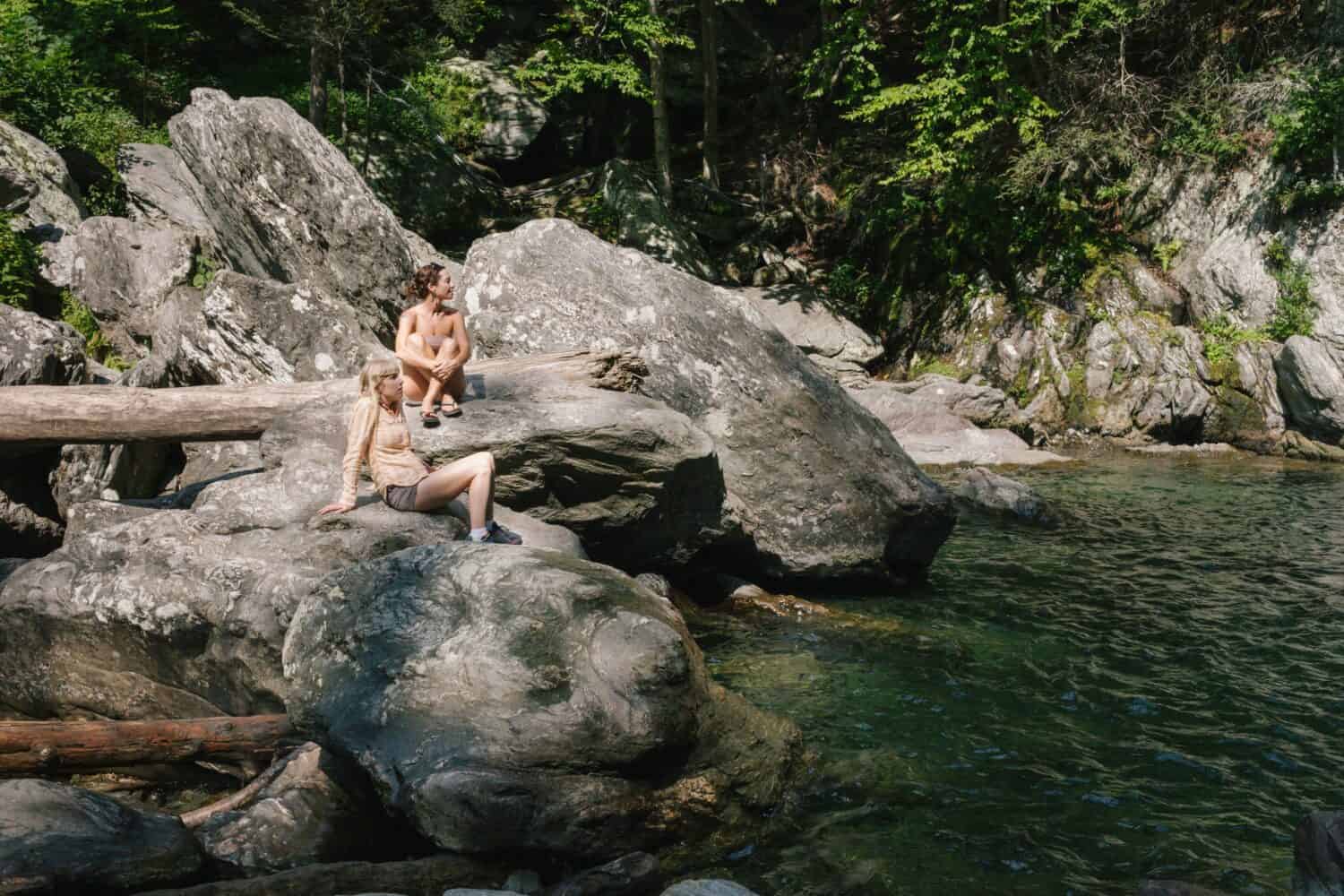
There are a variety of swimming holes nestled along the Wilson River in Oregon.
©CCISUL/Shutterstock.com
Best Time of Year to Go Swimming in the Wilson River
The best time of year for enjoying the Wilson River swimming holes depends on various factors, including water temperature, weather conditions, and personal preferences. It’s best to consider the seasonal variations and their impact on the river’s suitability to determine the optimal time for swimming.
Spring
During the spring months of March to May, the Wilson River experiences increased water flow due to snowmelt and rainfall. While the water may be colder during this period, some adventurous swimmers who enjoy brisk temperatures may find it invigorating. However, it’s important to exercise caution as swift currents and higher water levels can pose risks.
Summer
As summer approaches, the Wilson River becomes more inviting for swimming. From June to August, air temperatures rise, and the water in the river gradually warms up, providing a more comfortable swimming experience. This period is the peak of the swimming season when many visitors flock to the river’s swimming holes to cool off and enjoy the scenic beauty of the surrounding forest.
In early summer, water levels are typically lower, which may result in calmer currents and more accessible swimming areas. However, it’s still important to remain vigilant and aware of potential hazards, such as submerged rocks or logs, that could pose safety risks.
The late summer months of August and September can still be pleasant for swimming. However, the water levels may be lower, and the flow might reduce, resulting in slower-moving currents. Nevertheless, the Wilson River’s swimming holes can still offer refreshing retreats during this time, especially if the region experiences consistent rainfall.
Fall
During the fall season, from October to November, the Wilson River begins to cool down, mirroring the dropping temperatures in the air. Swimming during this time may be less popular as the water temperature cools and air temperatures decrease. Additionally, rainfall can increase, potentially leading to higher water levels and swifter currents.
Winter
Winter, from December to February, is generally not ideal for swimming in the Wilson River. Water temperatures drop significantly, and the weather conditions can be harsh, with colder air and increased rainfall. Swimming in the river during this season is not advised due to safety concerns related to frigid water temperatures and potentially dangerous currents.
Overall, the best time of year for enjoying Wilson River swimming holes is during the summer months of June to August when the water is warmer, air temperatures are pleasant, and water levels are generally more suitable for swimming. It’s crucial to exercise caution, be aware of any posted safety advisories, and consider personal swimming abilities and comfort levels when enjoying the Wilson River’s swimming holes.
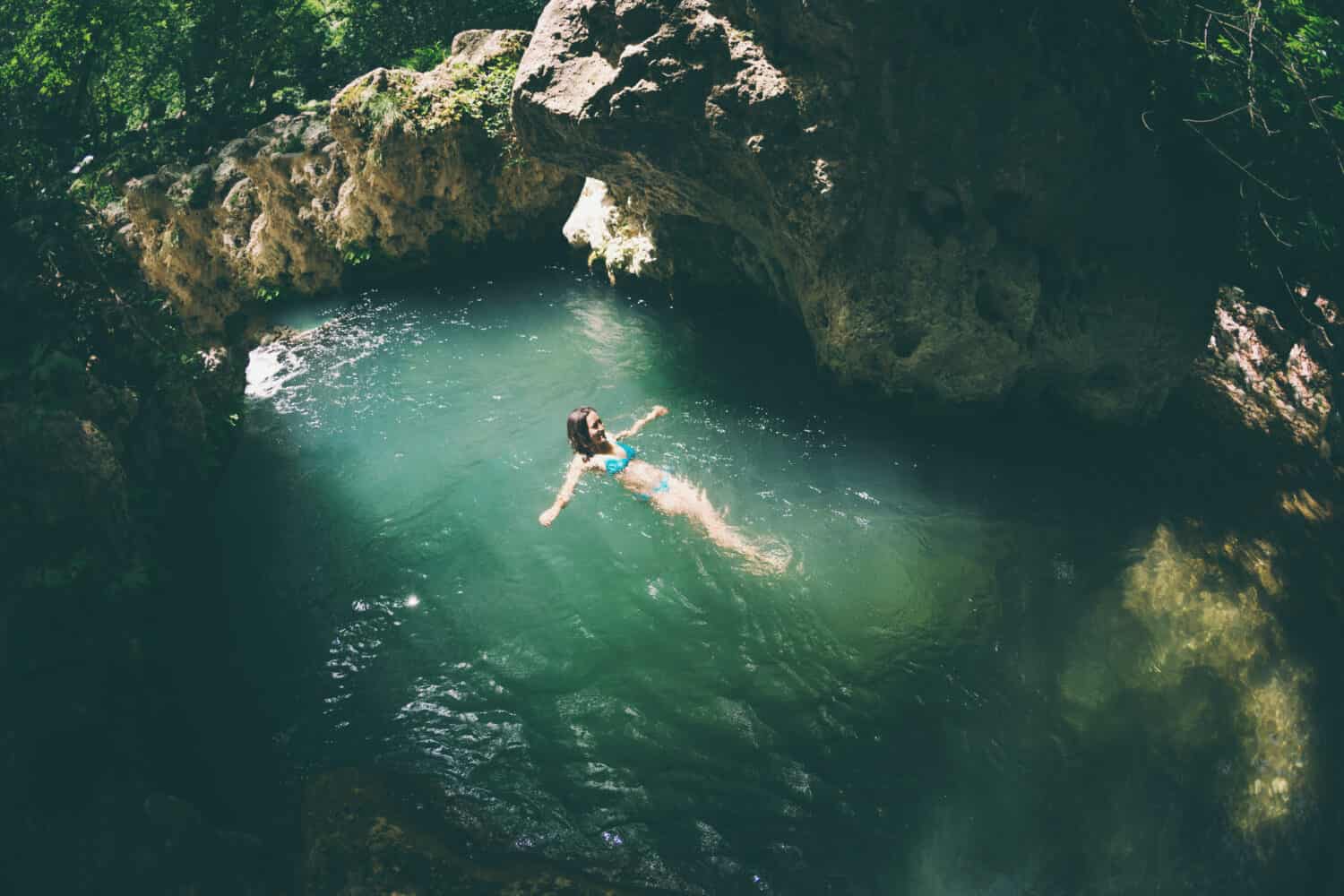
Swimming holes are popular locations to cool off on summer days and enjoy natural waters.
©Photo Volcano/Shutterstock.com
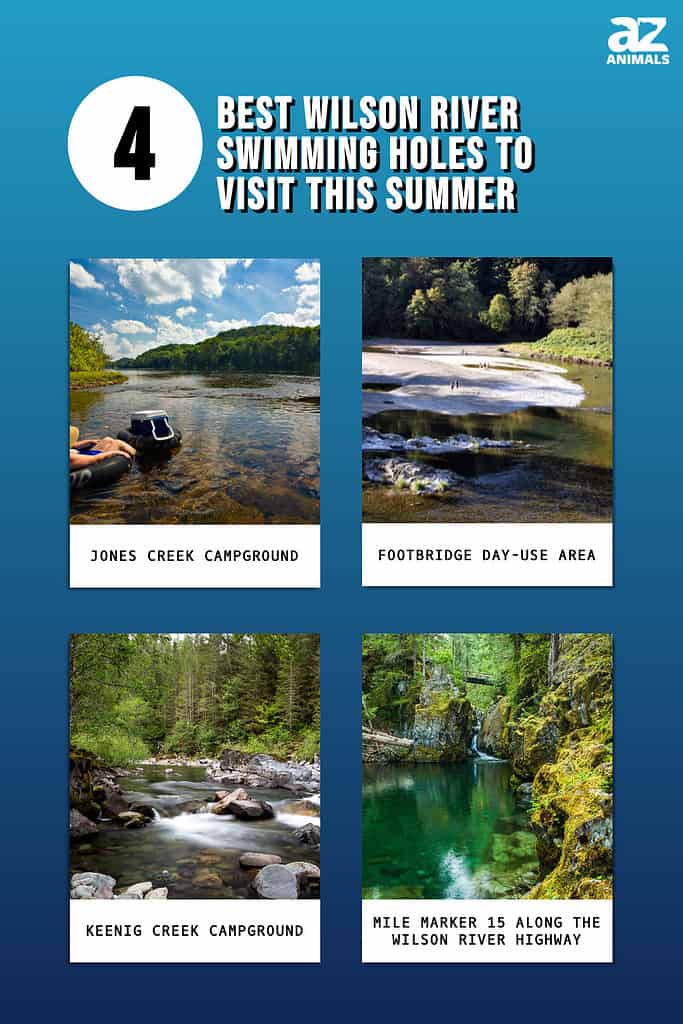
Jones Creek Campground
Jones Creek Campground is a delightful spot on the Wilson River. Situated within the picturesque Tillamook State Forest, this swimming hole is a hidden gem for nature enthusiasts and those seeking a refreshing dip in the river’s cool waters.
Jones Creek Campground is relatively easy to get to as its location is conveniently along the Wilson River. Accessing this spot requires taking the Wilson River Highway (Highway 6). Once in the Tillamook State Forest, you follow the designated roads to Jones Creek Campground. While some parts of the journey may be on unpaved roads, it is generally accessible to most vehicles.
Jones Creek Campground offers a range of swimming options for visitors. The swimming hole is the main attraction, where visitors can take a refreshing plunge into the crystal-clear waters of the Wilson River. The river’s gentle currents and scenic surroundings create a serene ambiance for swimmers to enjoy. Additionally, there are shallow areas suitable for wading and exploring, making it a family-friendly destination.
Camping enthusiasts will be pleased to know that Jones Creek Campground offers camping facilities, as the name suggests. They have amenities such as picnic tables, fire pits, and restroom facilities. Camping here allows visitors to fully immerse themselves in the area’s natural beauty and enjoy a tranquil evening under the starry skies.
Specific rules and regulations are in place to ensure the conservation and enjoyment of Jones Creek. Visitors need to adhere to these guidelines to preserve the pristine environment. Open fires, for example, may be restricted during dry seasons, so it’s crucial to check for any active restrictions. Additionally, while reservations are not required for day use, checking with Oregon State Parks for any updated information or changes to access and facilities is recommended.

Many swimming pools along the Wilson River have camping opportunities nearby.
©jack looney photography/Shutterstock.com
Footbridge Day-Use Area
The Footbridge day-use area is a captivating spot that offers a delightful experience for nature enthusiasts and swimmers alike.
The Footbridge day-use area is conveniently located on the Wilson River Highway (Highway 6) in Oregon, making it easily accessible for visitors. Situated within the Tillamook State Forest, this spot is marked by its namesake footbridge that spans the Wilson River. The trailhead day-use area is well-signposted, guiding visitors to the designated parking area.
Swimming options at the Footbridge day-use area are abundant, thanks to the calm and inviting waters of the Wilson River. The footbridge provides a vantage point for enjoying the river’s picturesque beauty. Visitors can venture down to the riverbank and find spots along the shoreline for wading or taking a refreshing dip in the cool waters. The sandy beach areas further enhance the swimming experience, allowing visitors to bask in the sun or play in the sand by the river. You can even enjoy cliff jumping here if you’re the adrenaline type. Furthermore, suppose you’re typing to avoid the crows and are willing to hike one to three miles. In that case, you can hike along the Wilson River Hiking Trail and discover even more swimming holes.
While camping is not directly available at the Footbridge day-use area, the Tillamook State Forest offers several nearby campgrounds that provide an opportunity to extend your stay and immerse yourself in the area’s natural beauty. Jones Creek Campground, near the Footbridge Trailhead, offers camping facilities and a serene atmosphere for overnight stays.
It is essential to observe the rules and regulations in place to ensure the preservation and enjoyment of the Footbridge day-use area. As with any outdoor recreation location, it is encouraged that visitors practice Leave No Trace principles.
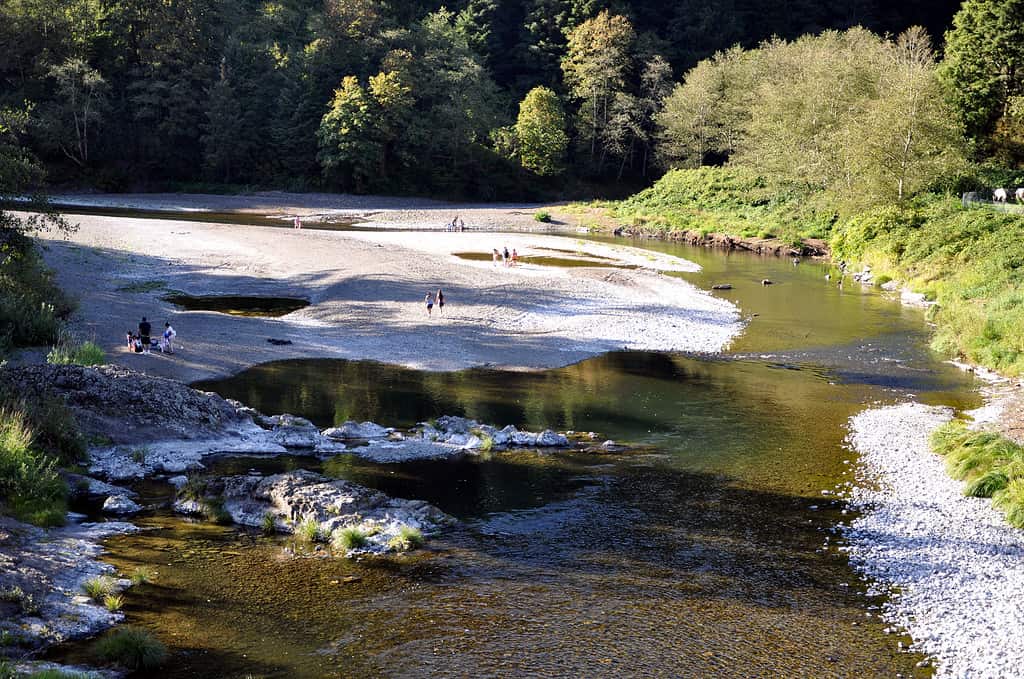
The Footbridge day-use area is conveniently located on the Wilson River Highway (Highway 6) in Oregon, making it easily accessible for visitors.
Keenig Creek Campground
The Keenig Creek Campground is a tranquil retreat that offers a serene location with plentiful swimming options and recreational activities.
This campground is located near the Wilson River along the tributary Keenig Creek, providing visitors easy access to its picturesque setting. To reach this spot, visitors can take the same Wilson River Highway (Highway 6) and watch for signs indicating the entrance to the campground. The campground is typically well-marked, making it relatively easy to find.
Various swimming spots surround Keenig Creek Campground. There are deep pools and big rocks for lounging about. The location provides a serene and relaxing atmosphere for visitors to enjoy, especially on hot summer days. Surrounded by towering trees and nestled along the creek, visitors can immerse themselves in nature’s soothing sounds and appreciate the peaceful ambiance. Overall, it is a refreshing location for a dip in the cool waters.
Keenig Creek Campground is small but makes up for it with its abundant swimming options. It also offers various recreational activities for visitors to enjoy. Nature enthusiasts can explore the forested trails, take leisurely walks, or embark on invigorating hikes amidst the scenic beauty. The campground is equipped with amenities such as picnic tables and fire pits, providing opportunities for outdoor dining and cozy campfire gatherings under the starry night sky.
As with all campgrounds, there are rules and regulations in place at Keenig Creek Campground. Visitors must follow the guidelines outlined by Oregon State Parks, including proper waste disposal, respecting quiet hours, and adhering to campground regulations. While reservations may be optional, this campground can fill up quickly due to its limited spots. You can check with Oregon State Parks for any updates, regulations, or changes to access and facilities.

Wilson River is a popular river to enjoy swimming holes.
©Bureau of Land Management Oregon and Washington / CC BY 2, Flickr – Original / License
Mile Marker 15 Along the Wilson River Highway
Mile marker 15 is often and easily passed up, considering it’s not labeled or advertised as a day-use area or campground.
You can find this location along the Wilson River at mile marker 15, situated on a bend in the road. It provides easy access for visitors. Visitors can follow the Wilson River Highway (Highway 6) to get to this spot until they reach mile marker 15. Once there, finding safe parking along the highway is the most viable option.
Swimming options here are generous for swimming activities. Visitors can take a refreshing dip in the cool and clear waters. The large swimming hole provides an ideal setting to beat the heat and enjoy the natural beauty of the Wilson River. From shallow areas suitable for wading to deeper sections for a proper swim, this location caters to various preferences and skill levels.
This area of the Wilson River is deep and holds a stunning pool that is wonderful for swimming. Due to its location, it is a unique spot to enjoy the tranquil waters without the crowds. Many rocks along the water’s edge add to the beauty of the scenery and comfortable sunbathing opportunities
There is no camping in this day-use area. However, several campgrounds are nearby, including the Jones Creek Campground and Keenig Creek Campground. Both offer camping facilities and the opportunity for visitors to fully immerse themselves in the beauty of the surroundings, awakening to the sounds of nature and enjoying the atmosphere.
As with all outdoor destinations, no matter who manages the land, it is essential to dispose of waste properly, be mindful of noise levels and other visitors, respect flora and fauna, leave the area as you found it, and minimize environmental impact.

There are plenty of unmarked swimming spots along the Wilson River.
©Bob Pool/Shutterstock.com
Wildlife Found in and Around the Wilson River
The Wilson River in Oregon is a haven for wildlife, with its diverse ecosystem supporting a wide range of species.
Birds are abundant along the Wilson River, adding a colorful and melodic presence to the surroundings. Look out for the magnificent bald eagle soaring high above the river, its keen eyes searching for fish. You can spot great blue herons wading in the shallow waters, gracefully searching for their next meal, too. The Wilson River also attracts a variety of waterfowl, including kingfishers, ducks, and geese, adding their unique calls to the symphony of nature.
Many mammals call the Wilson River home. With their playful nature, you can often see river otters frolicking in the water, gracefully diving and surfacing as they search for fish and other aquatic prey. With their elegant appearance, you white-tailed deer can occasionally be spotted at the river’s edge, gracefully drinking from the cool waters. Squirrels and chipmunks scurry through the trees, their nimble movements adding a touch of liveliness to the forested areas surrounding the river.
The Wilson River also supports a rich aquatic ecosystem, hosting a variety of fish species. Salmon, including the Chinook salmon and coho salmon, undertake their remarkable upstream journey to spawn in the river’s tributaries. Steelhead, a prized sportfish, can also be found in the Wilson River, enticing anglers with their impressive size and strength.
As you explore the banks, note the vibrant insect life buzzing around. Dragonflies and damselflies, with their iridescent wings, dart through the landscape. Butterflies like the Oregon Swallowtail delicately flutter from flower to flower, sipping nectar and pollinating plants.
All wildlife should be observed from a respectful distance, allowing animals to go about their natural behaviors undisturbed. By practicing responsible wildlife viewing, we can ensure the preservation and well-being of these remarkable creatures.

Across the state of Oregon, there are many rivers to explore.
©Michael Balada/Shutterstock.com
The Importance of Leave No Trace
While enjoying the best Wilson River swimming holes this summer, it is important to remember the basic principles of Leave No Trace when venturing into the natural world. Leave No Trace is a crucial concept that emphasizes responsible outdoor behavior and environmental stewardship. It guides individuals to minimize their impact on natural areas, ensuring the preservation and enjoyment of our precious ecosystems. Let’s explore the importance of Leave No Trace principles and their significance in promoting sustainable outdoor practices.
Leave No Trace encourages visitors to minimize their environmental impact by following a set of guidelines. These principles include the following.
Plan and Prepare
Proper planning ensures a safe and enjoyable outdoor experience. Research the area, be aware of regulations and potential hazards, and equip yourself with the necessary supplies. By planning, you can minimize potential environmental damage.
Travel and Camp on Durable Surfaces
Stick to established trails and campsites to avoid trampling fragile vegetation. Using durable surfaces such as rocks, gravel, or established campsites helps preserve the natural landscape and prevents soil erosion.
Dispose of Waste Properly
Carry out all trash and dispose of it in designated receptacles. This includes food waste, as it can disrupt natural ecosystems and attract wildlife to human areas. Proper waste disposal keeps the environment clean and minimizes the risk of pollution.
Leave What You Find
Refrain from disturbing natural features, historical artifacts, or wildlife habitats. Leave rocks, plants, and other natural objects as you find them, allowing others to appreciate the area’s natural beauty.
Minimize Campfire Impacts
Campfires can cause lasting damage, so use established fire rings or designated areas. Always follow local regulations regarding fire safety and make sure to thoroughly extinguish fires before leaving.
Respect Wildlife
Observe wildlife from a distance and avoid approaching or feeding them. Feeding animals can disrupt their natural behaviors and lead to dependence on human food sources, which can harm their health.
Be Considerate of Other Visitors
Show respect for fellow outdoor enthusiasts by keeping noise levels down and allowing space for others to enjoy the environment. Avoid disturbing wildlife or other visitors by maintaining a respectful distance.
By adhering to these principles, individuals contribute to the sustainability and long-term preservation of natural areas. Leave No Trace practices protect delicate ecosystems and ensure that future generations can experience and appreciate the beauty of the outdoors.
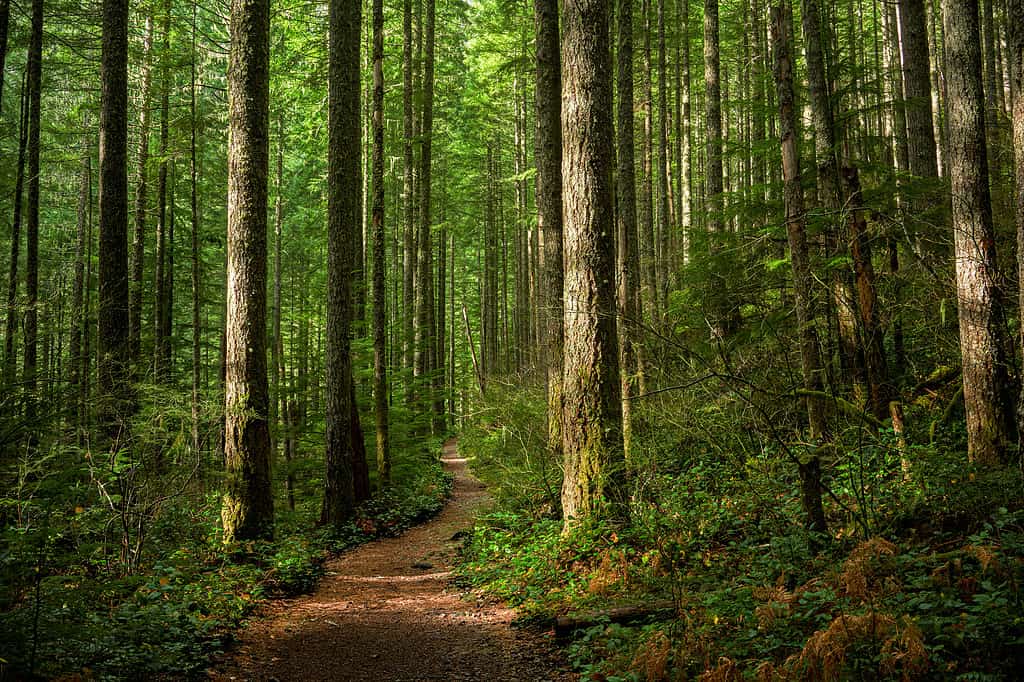
The Wilson River runs through the Tillamook State Forest.
©iStock.com/Alexander Fattal
Conclusion
In conclusion, the best Wilson River swimming holes offer a range of enchanting swimming opportunities that attract visitors seeking a refreshing and scenic aquatic experience. From sandy beaches, smooth rock surfaces, swimming pools, and even campgrounds, each location resides within the Tillamook State Forest along the Wilson River Highway (Highway 6). Complemented by the abundant wildlife in and around the river, these locations are home to bird species, river otters, and diverse fish populations. Visitors should follow regulations and practice Leave No Trace principles to ensure a harmonious experience and preserve the natural beauty of the Wilson River for future generations to enjoy.
Summary of the 4 Best Wilson River Swimming Holes
| Rank | Swimming Hole | Location | Activities & Amenities |
|---|---|---|---|
| 1 | Jones Creek Campground | Tillamook State Forest | Camping, swimming, picnic tables, fire pits, and restroom facilities |
| 2 | Footbridge Day-Use Area | Tillamook State Forest | Hiking, swimming, cliff jumping |
| 3 | Keenig Creek Campground | Tillamook State Forest | Camping, swimming, hiking, picnic tables, and fire pits |
| 4 | Mile Marker 15 Along the Wilson River Highway | On an inconspicuous bend where the Wilson River deepens and slows into a pool. | Swimming |
Thank you for reading! Have some feedback for us? Contact the AZ Animals editorial team.







